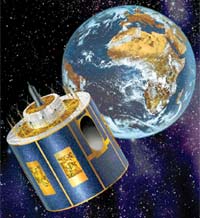A new generation European meteorological satellite is being launched in September with a new UK instrument to study the global Earth radiation budget (GERB), says the British National Space Centre.
The GERB instrument has been developed by a UK-led consortium which includes the Natural Environment Research Council, Rutherford Appleton Laboratory and Imperial College. GERB will measure solar radiation reflected by the atmosphere and thermal radiation – or heat – emitted by the Earth.
The balance between the incoming radiation from the Sun and the radiation returned to space is an important factor controlling the climate.

Engine
"GERB is the Earth's engine. Heat energy retained and lost modifies the balance of the climate," says Jacqui Russel of Imperial College.
The inclusion of the GERB instrument was made possible by the increased size of the Meteosat Second Generation (MSG) spacecraft.
To be carried into geostationary orbit (GEO) aboard an Ariane 5 booster from Kourou, South America, the 3.2m diameter MSG craft, at 2,000kg, is three times the size of the first generation of seven Meteosats, the first of which was launched in 1977. Three MSG craft are to be launched.
MSG 2 will carry a suite of state-of-the-art instruments to monitor weather patterns and improve storm warnings.
The satellite will improve long-term forecasts and conduct global climate research, including monitoring the depletion of the ozone layer.
Improvement
"Satellites have provided a 50% improvement in weather forecasting," says Ewen McCallum of the UK Met Office.
MSG's ozone channel is the first to be carried on a European GEO satellite and will lead to daily forecasts and conduct global climate research, including monitoring the depletion of the ozone layer.
Another major innovation aboard MSG is the Spinning Enhanced Visible and Infrared Imager (SEVERI), an uprated version of the instrument flown on the first generation Meteosats, measuring visible light, thermal infrared and water vapour in 12 thermal wavelengths, rather than five. The images will have a resolution of 1km.
Source: Flight Daily News























